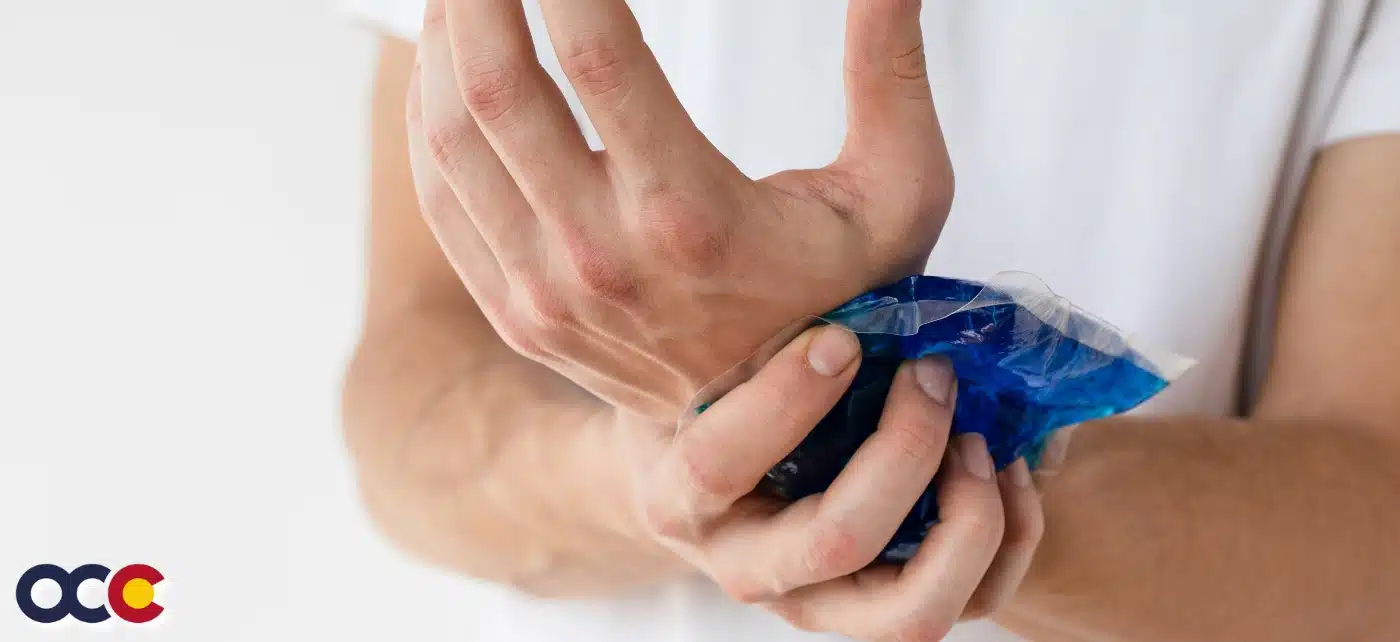[av_textblock size=” font_color=” color=” av_uid=’av-lss6dx’]
Signs & Symptoms | Causes | Diagnosis | Prevention | Treatment | Conservative | Surgery | Rehabilitation
[/av_textblock]
[av_textblock size=” av-medium-font-size=” av-small-font-size=” av-mini-font-size=” font_color=” color=” id=” custom_class=” template_class=” av_uid=’av-laagc5′ sc_version=’1.0′ admin_preview_bg=”]
Carpal tunnel syndrome (CTS)
Carpal tunnel syndrome (CTS) is a medical condition due to compression of the median nerve as it travels through the wrist at the carpal tunnel. The main symptoms are pain, numbness and tingling, in the thumb, index finger, middle finger, and the thumb side of the ring fingers. Symptoms typically start gradually and during the night. Pain may extend up the arm. Weak grip strength may occur and after a long period of time the muscles at the base of the thumb may waste away. In more than half of cases both sides are affected.
Risk factors include obesity, repetitive wrist work, pregnancy, and rheumatoid arthritis. There is tentative evidence that hypothyroidism increases the risk. It is unclear if diabetes plays a role. Types of work that are associated include computer work, work with vibrating tools, and work that requires a strong grip. Diagnosis is suspected based on signs, symptoms, and specific physical tests and may be confirmed with electrodiagnostic tests. If muscle wasting at the base of the thumb is present, the diagnosis is likely.
Being physically active can decrease the risk of developing CTS. Symptoms can be improved by wearing a wrist splint or with corticosteroid injections. Surgery to cut the transverse carpal ligament is effective with better results at a year compared to non-surgical options. Further splinting after surgery is not needed.
About 5% of people in the United States have carpal tunnel syndrome. It usually begins in adulthood and women are more commonly affected than men. Up to 33% of people may improve without specific treatment over approximately a year.
[/av_textblock]
[av_textblock size=” font_color=” color=” av_uid=’av-iy2h3p’]
Signs and Symptoms
People with CTS experience numbness, tingling, or burning sensations in the thumb and fingers, in particular the index and middle fingers and radial half of the ring finger, because these receive their sensory and motor function (muscle control) from the median nerve. Ache and discomfort can possibly be felt more proximally in the forearm or even the upper arm. Less-specific symptoms may include pain in the wrists or hands, loss of grip strength, and loss of manual dexterity.
Some suggest that median nerve symptoms can arise from compression at the level of the thoracic outlet or the area where the median nerve passes between the two heads of the pronator teres in the forearm, although this is debated.
Numbness and paresthesias in the median nerve distribution are the hallmark neuropathic symptoms (NS) of carpal tunnel entrapment syndrome. Weakness and atrophy of the thumb muscles may occur if the condition remains untreated, because the muscles are not receiving sufficient nerve stimulation. Discomfort is usually worse at night and in the morning.
[/av_textblock]
[av_textblock size=” font_color=” color=” av_uid=’av-hc4kid’]
Causes
Most cases of CTS are of unknown cause. Carpal tunnel syndrome can be associated with any condition that causes pressure on the median nerve at the wrist. Some common conditions that can lead to CTS include obesity, hypothyroidism, arthritis, diabetes, prediabetes (impaired glucose tolerance), and trauma. Genetics play a role. Carpal tunnel is a feature of a form of Charcot-Marie-Tooth syndrome type 1 called hereditary neuropathy with liability to pressure palsies.
Other causes of this condition include intrinsic factors that exert pressure within the tunnel, and extrinsic factors (pressure exerted from outside the tunnel), which include benign tumors such as lipomas, ganglion, and vascular malformation. Carpal tunnel syndrome often is a symptom of transthyretin amyloidosis-associated polyneuropathy and prior carpal tunnel syndrome surgery is very common in individuals who later present with transthyretin amyloid-associated cardiomyopathy, suggesting that transthyretin amyloid deposition may cause carpal tunnel syndrome.
The median nerve can usually move up to 9.6 mm to allow the wrist to flex, and to a lesser extent during extension. Long-term compression of the median nerve can inhibit nerve gliding, which may lead to injury and scarring. When scarring occurs, the nerve will adhere to the tissue around it and become locked into a fixed position, so that less movement is apparent.
Normal pressure of the carpal tunnel has been defined as a range of 2–10 mm, and wrist flexion increases this pressure 8-fold, while extension increases it 10-fold. Repetitive flexion and extension in the wrist significantly increase the fluid pressure in the tunnel through thickening of the synovial tissue that lines the tendons within the carpal tunnel.
[/av_textblock]
[av_textblock size=” font_color=” color=” av_uid=’av-g259gl’]
Diagnosis
There is no consensus reference standard for the diagnosis of carpal tunnel syndrome. A combination of described symptoms, clinical findings, and electrophysiological testing may be used. CTS work up is the most common referral to the electrodiagnostic lab. Historically, diagnosis has been made with the combination of a thorough history and physical examination in conjunction with the use of electrodiagnostic (EDX) testing for confirmation. Additionally, evolving technology has included the use of ultrasonography in the diagnosis of CTS. However, it is well established that physical exam provocative maneuvers lack both sensitivity and specificity. Furthermore, EDX cannot fully exclude the diagnosis of CTS due to the lack of sensitivity. A Joint report published by the American Association of Neuromuscular and Electrodiagostic Medicine (AANEM), the American Academy of Physical Medicine and Rehabilitation (AAPM&R) and the American Academy of Neurology defines practice parameters, standards and guidelines for EDX studies of CTS based on an extensive critical literature review. This joint review concluded median and sensory nerve conduction studies are valid and reproducible in a clinical laboratory setting and a clinical diagnosis of CTS can be made with a sensitivity greater than 85% and specificity greater than 95%. Given the key role of electrodiagnostic testing in the diagnosis of CTS, The American Association of Neuromuscular & Electrodiagnostic Medicine has issued evidence-based practice guidelines, both for the diagnosis of carpal tunnel syndrome.
Numbness in the distribution of the median nerve, nocturnal symptoms, thenar muscle weakness/atrophy, positive Tinel’s sign at the carpal tunnel, and abnormal sensory testing such as two-point discrimination have been standardized as clinical diagnostic criteria by consensus panels of experts. Pain may also be a presenting symptom, although less common than sensory disturbances.
Electrodiagnostic testing (electromyography and nerve conduction velocity) can objectively verify the median nerve dysfunction. Normal nerve conduction studies, however, do not exclude the diagnosis of CTS. Clinical assessment by history taking and physical examination can support a diagnosis of CTS. If clinical suspicion of CTS is high, treatment should be initiated despite normal electrodiagnostic testing.
[/av_textblock]
[av_textblock size=” font_color=” color=” av_uid=’av-ejzgk5′]
Prevention
Suggested healthy habits such as avoiding repetitive stress, work modification through use of ergonomic equipment (wrist rest, mouse pad), taking proper breaks, using keyboard alternatives (digital pen, voice recognition, and dictation), and have been proposed as methods to help prevent carpal tunnel syndrome. The potential role of B-vitamins in preventing or treating carpal tunnel syndrome has not been proven.
Stretches and isometric exercises will aid in prevention for persons at risk. Stretching before the activity and during breaks will aid in alleviating tension at the wrist. Place the hand firmly on a flat surface and gently pressing for a few seconds to stretch the wrist and fingers. An example for an isometric exercise of the wrist is done by clenching the fist tightly, releasing and fanning out fingers. None of these stretches or exercises should cause pain or discomfort.
Biological factors such as genetic predisposition and anthropometric features had significantly stronger causal association with carpal tunnel syndrome than occupational/environmental factors such as repetitive hand use and stressful manual work. This suggests that carpal tunnel syndrome might not be preventable simply by avoiding certain activities or types of work/activities.
[/av_textblock]
[av_textblock size=” font_color=” color=” av_uid=’av-d6smk5′]
Treatment
Generally accepted treatments include: physiotherapy, steroids either orally or injected locally, splinting, and surgical release of the transverse carpal ligament. There is insufficient evidence for ultrasound, yoga, lasers, vitamin B6, and exercise. Change in activity may include avoiding activities that worsen symptoms.
The American Academy of Orthopedic Surgeons recommends proceeding conservatively with a course of nonsurgical therapies tried before release surgery is considered. A different treatment should be tried if the current treatment fails to resolve the symptoms within 2 to 7 weeks. Early surgery with carpal tunnel release is indicated where there is evidence of median nerve denervation or a person elects to proceed directly to surgical treatment. Recommendations may differ when carpal tunnel syndrome is found in association with the following conditions: diabetes mellitus, coexistent cervical radiculopathy, hypothyroidism, polyneuropathy, pregnancy, rheumatoid arthritis, and carpal tunnel syndrome in the workplace.
[/av_textblock]
[av_textblock size=” font_color=” color=” av_uid=’av-bd5l45′]
Conservative
Splints
Many health professionals suggest that, for the best results, one should wear braces at night and, if possible, during the activity primarily causing stress on the wrists.
Corticosteroids
Corticosteroid injections can be effective for temporary relief from symptoms while a person develops a long-term strategy that fits their lifestyle. The injections are done under local anesthesia. This treatment is not appropriate for extended periods, however. In general, local steroid injections are only used until other treatment options can be identified.
[/av_textblock]
[av_textblock size=” font_color=” color=” av_uid=’av-9es5et’]
Surgery
Release of the transverse carpal ligament is known as “carpal tunnel release” surgery. It is recommended when there is static (constant, not just intermittent) numbness, muscle weakness, or atrophy, and when night-splinting or other conservative interventions no longer control intermittent symptoms. The surgery may be done with local or regional anesthesia with or without sedation, or under general anesthesia. In general, milder cases can be controlled for months to years, but severe cases are unrelenting symptomatically and are likely to result in surgical treatment.
Surgery is more beneficial in the short term to alleviate symptoms (up to six months) than wearing an orthosis for a minimum of 6 weeks. However, surgery and wearing a brace resulted in similar symptom relief in the long term (12-18 month outcomes).
[/av_textblock]
[av_textblock size=” font_color=” color=” av_uid=’av-6xecd1′]
Rehabilitation
A recent evidence based guideline produced by the American Academy of Orthopedic Surgeons assigned various grades of recommendation to physiotherapy (also called physical therapy) and other nonsurgical treatments. One of the primary issues with physiotherapy is that it attempts to reverse (often) years of pathology inside the carpal tunnel. Practitioners caution that any physiotherapy such as myofascial release may take weeks of persistent application to effectively manage carpal tunnel syndrome.
Again, some claim that pro-active ways to reduce stress on the wrists, which alleviates wrist pain and strain, involve adopting a more ergonomic work and life environment. For example, some have claimed that switching from a QWERTY computer keyboard layout to a more optimised ergonomic layout such as Dvorak was commonly cited as beneficial in early CTS studies, however some meta-analyses of these studies claim that the evidence that they present is limited.
[/av_textblock]
[av_one_full first first min_height=” vertical_alignment=’av-align-top’ space=” margin=’0px’ margin_sync=’true’ padding=’20px’ padding_sync=’true’ border=” border_color=” radius=’0px’ radius_sync=’true’ background_color=’#e0e0e0′ src=” attachment=” attachment_size=” background_position=’top left’ background_repeat=’no-repeat’ animation=” av_uid=’av-6h57jp’]
[av_textblock size=” font_color=” color=” av_uid=’av-4pvh39′]
Source
Content provided by Wikipedia
Text is available under the Creative Commons Attribution-ShareAlike License
[/av_textblock]
[/av_one_full]
[av_social_share title=’Share this entry’ style=” buttons=” share_facebook=” share_twitter=” share_pinterest=” share_gplus=” share_reddit=” share_linkedin=” share_tumblr=” share_vk=” share_mail=” av_uid=’av-3304sl’]









